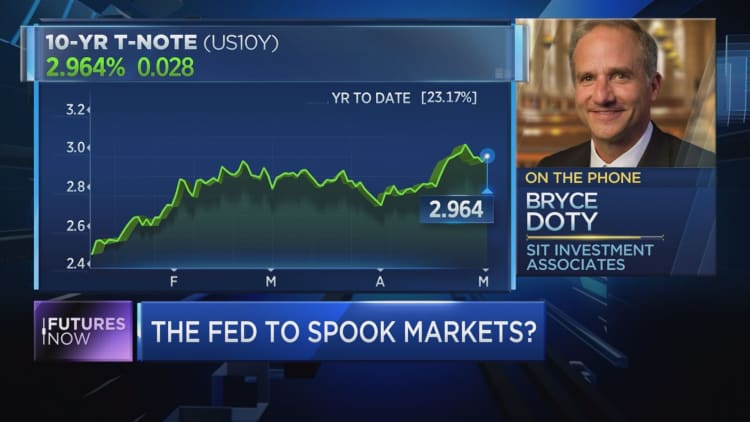
Investors are shoveling money into bonds at a furious pace, despite having virtually every conceivable reason to ditch the sector.
April, in fact, saw the most money devoted to fixed income since October 2014, coming despite tumult over a multi-year peak in several government bond yields that fueled worry over a broader turn in market conditions and higher inflation.
Fixed income ETFs, which follow bond market indexes, took in just shy of $16 billion in investor cash during the month, dwarfing the $10 billion dedicated to funds that track the stock market, according to FactSet.
Moreover, the money was distributed fairly evenly among funds that tracked both short- and long-duration bonds. That's despite the benchmark 10-year Treasury note yield briefly topping the 3 percent mark, considered by many experts to be a critical point. Fixed income investors, particularly those who buy bond funds, don't like higher rates as they mean lower prices.
Mutual funds have shown similar traits this year. Investors pulled nearly $11 billion out of U.S. equity funds in the first quarter and $205.6 billion over the past 12 months, according to Morningstar. Taxable bond mutual funds took in $9 billion in the first three months and $170.1 billion during the past year.
In all, the flows during the month, and throughout 2018 so far, show that investors are still not ready to go all-in for a stock market bull that is now 9 years old, the second-longest in history.
"The most hated US equity bull market of all time has lost none of its ability to both repulse fresh capital and still live to fight another day," Nick Colas, co-founder of DataTrek Research, said in his daily market note.
Colas' point is important on two levels: The "most hated" moniker has stuck with the market since the early part of this decade and has been both a source of aggravation and support for the aging bull.
Bulls wonder why more people haven't bought in, but that skepticism has prevented a full-out stocks fervor that typically leads to a bear market. (This writer mused that "maybe it should be" despised back in 2013, a time when market leadership was based mostly on stocks that possessed the worst fundamentals.)
Investor interest has continued in fixed income even though returns have been muted during a run when the has soared about 300 percent since its March 2009 lows.
This year's wild stock market swings have proven to be a friend to bonds and have thwarted multiple predictions that 2018 finally would end the more than 30-year bond bull.
"The first-quarter volatility that we saw in equities did seem to unnerve investors and remind them that they probably do want to have diversification in their portfolios," Steve Laipply, head of fixed income strategy for BlackRock's iShares ETF family, said in an interview. "We had a very nice run in equities in 2017. There was quite a bit of turmoil in the first quarter of 2018. I think investors reacted rationally in diversifying their risk."
Several funds have benefited notably.
The iShares Short Treasury Bond, which focuses on duration from one month to one year, saw $2.5 billion in new money over the past month and $5.8 billion year to date, a 73 percent surge. The ETF has seen $4.4 billion in inflows, an 8.5 percent growth. Conversely, the SPDR S&P 500 ETF, the most popular passive stock market investment with $256.8 billion in assets, has seen $19 billion in outflows this year.
The trouble for investors this year is that most asset classes have moved little in either direction, though there are opportunities in stock selection and in individual commodities.
In that environment, money has moved to cash and its equivalents and away from risk, particularly in U.S. assets. Cash has risen to 16.6 percent of investor portfolios, the largest share since May 2017, according to the American Association of Individual Investors.
At the same time, there's good deal of policy uncertainty.
The Federal Reserve is on track to raise interest rates three or four times this year, and the Trump administration is threatening broad-based tariffs that many investors fear could start a trade war and fuel inflation.
Taken together, it's made for an environment friendly to safe-haven bonds.
"What we tend to find is that investors will look to offset the riskier assets in their portfolios such as equities," Laipply said. "They may have a preference for where they want rates to be, but ultimately they will still make that allocation."
WATCH: Bumpy ride for bonds



